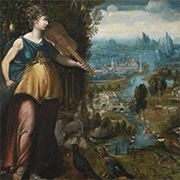The courtly Opéra-ballet Les Fêtes d'Hébé was premiered in May 1739 at the Académie royale de musique in Paris and was immediately extremely successful. Rameau had probably not reckoned on such a resounding success with a work he had evidently composed very quickly, to a libretto by dilettante authors who shared the same box at the Opéra – Antoine-César Gaultier de Montdorge and Louise-Angélique Rondin de La Tournerie. Their idea of writing a libretto for a ballet occurred to them following the performances of Les Indes galantes in 1735. In that year, Rameau had been unable to perform his tragedy Samson, based on a libretto by Voltaire, because of the censor, and so he decided to re-use a large portion of the music from Samson in his score for Les Fêtes d’Hébé.
As novices in the art of verse-writing, Montdorge and Madame Bersin were assisted by two renowned dramatists, the Abbé Simon-Joseph Pellegrin and Pierre-Joseph Bernard (known as Gentil-Bernard). The librettists chose as the theme of their ballet the arts which are usually found on the stage in opera, all placed at the service of love: the art of versification and of declamation (La Poesie), the art of song and of harmony (La Musique) and finally the art of choreography (La Danse), all combined in a single work, which gave rise to the alternative title of the ballet, Les Fêtes d'Hébé ou Les Talents lyriques.
From its very first performance the work was widely acclaimed by audiences, who flocked to see it in droves. It was only the entrée La Musique which was unsuccessful because of the figurative ballet, judged as insufficiently clear to allow Iphise to imagine the victory of his beloved Tirtée. But this was something novel at the time which, inspired by the marvellous ballet Les Fleurs in Les Indes galantes, is evidence of Rameau’s interest in the art of choreography. In June 1739 composer and his librettists proposed a new version of this entrée, which placed the couple of Iphise and Tirtée more in the centre of the action and removed the superfluous role of the King Licurgue. This time, the triumph of Les Fêtes d'Hébé was ensured. Its numerous revivals and the reviews in the press are evidence of the enduring success of this ballet with Parisian audiences: it was revived in July 1747 (with a few alterations), then in May 1756 and finally in June 1764. It was also performed in Lyon in 1740 and 1749. After this, the entrées La Musique and La Danse continued to be performed regularly at the Paris Opéra and at court (until 1775 and 1778 respectively).
This critical new edition is based on the orchestral materials used by the singers and musicians of the Opéra between 1739 and 1764. The main section presents the version from June 1739 with the prologue, La Poésie, La Musique (2nd version) and La Danse, and the subsequent appendix contains the alterations of 1747, 1756 and 1764, as well as the first version of La Musique. Close study of the original performance material of this last entrée, preserved in the Opéra Garnier in Paris, has made it possible to recreate the exact orchestration for the first time as well as the gaps in the edition published by Rameau in 1739. It has therefore been possible to reconstruct the original double bass part – independent of the basses de violin (the later violoncello) – evidence of a very original use of this instrument at the Paris Opéra during Rameau’s time. Its function was to strengthen the harmonic basis.
The new edition and the performance material were used for the first time in March 2021 in making the CD recording for the Glossa label in Budapest, conducted by György Vashegyi, with soloists, the Purcell Choir and the Orfeo Orchestra.
Pascal Denécheau
(June 2021 / translation: Elizabeth Robinson)



